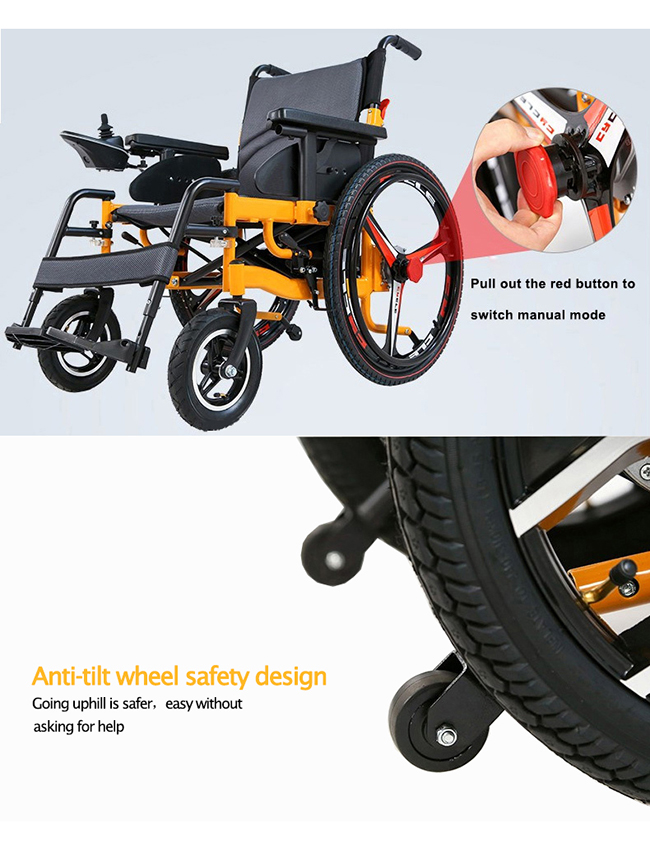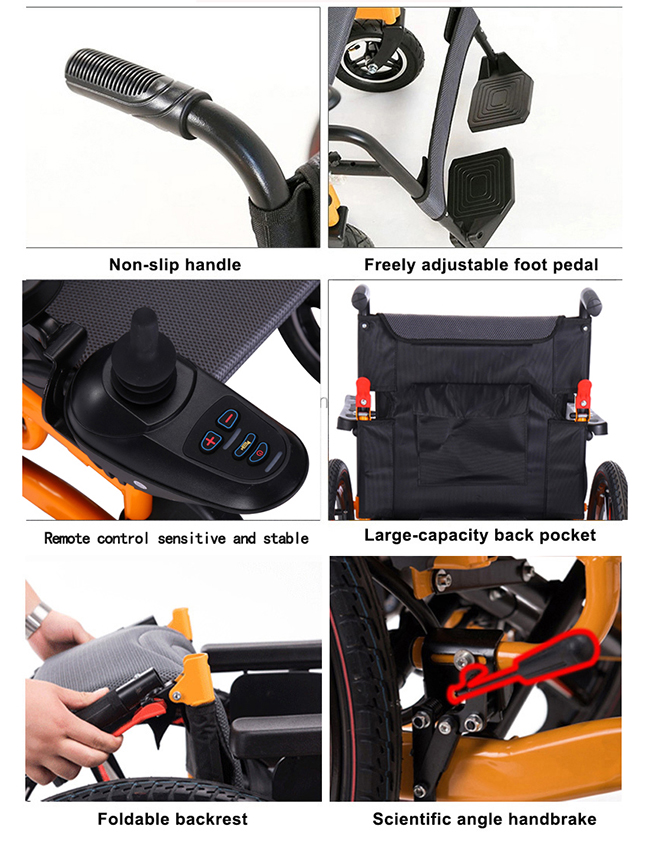Analysis of Electric Wheelchair Design Structure: From Engineering Principles to Commercial Value
Against the backdrop of accelerating global aging and surging demand for assistive devices, electric wheelchairs have evolved from simple mobility tools to comprehensive solutions integrating mechanical engineering, ergonomics, and intelligent technologies. For professional wholesale buyers in Europe and the United States, a thorough understanding of the design structure of electric wheelchairs is not only fundamental to product selection but also crucial for optimizing the supply chain and meeting end-user needs. This article systematically dissects the core structural components of an electric wheelchair, analyzing its design logic and performance relationships, providing a professional reference for purchasing decisions.
1. Drive System: The Core Carrier of Power and Control
The drive system is the “heart” of an electric wheelchair, directly determining its mobility, endurance, and control precision. Its design must balance power output with energy efficiency.
Most electric wheelchairs use a dual-motor drive solution, with each rear wheel controlled by an independent brushless DC motor, and steering achieved through differential speed. This design offers the advantages of fast response and a turning radius as low as 0.8 meters, making it suitable for confined spaces such as homes and hospitals. Motor power typically ranges from 250W to 500W, with the power selection closely tied to the wheelchair’s load capacity: a 250W motor is suitable for lightweight models with a load capacity of less than 120kg, while a 500W motor can handle heavier models over 180kg. It’s worth noting that the European and American markets have strict requirements for motor energy efficiency. Motors that meet the EU EPAC standard must have energy recovery capabilities, converting kinetic energy into electrical energy to recharge the battery during downhill driving or deceleration, extending battery life by approximately 15%.
As a power source, the choice of battery system directly impacts product competitiveness. Currently, the two most popular commercially available options are 12V lead-acid battery packs (connected in series to form a 24V system) and lithium-ion battery packs. Lead-acid batteries cost only one-third of lithium batteries and have a cycle life of approximately 300 cycles, making them suitable for budget-constrained scenarios. Lithium batteries boast an energy density of 150Wh/kg, three times that of lead-acid batteries, a cycle life of over 800 cycles, and fast charging (80% full in two hours), making them more suitable for the portability and durability demands of the European and American markets. Battery capacity is typically specified in Ah (ampere-hours). For example, a 24V 20Ah battery paired with a 300W motor can achieve a range of approximately 20 kilometers, while a 24V 40Ah lithium battery can support long-distance travel of over 45 kilometers.
The control system is the “nerve center” connecting the user and the device, consisting of a joystick, a controller board, and a display. Professional-grade electric wheelchairs use a programmable controller that adjusts sensitivity based on user habits, such as setting a delayed response mode for users with hand tremors. In addition to displaying battery level and speed, the display monitors motor temperature and battery status in real time. Fault codes are automatically displayed, allowing maintenance personnel to quickly identify the problem. Some high-end models are equipped with Bluetooth modules, which support remote parameter adjustment via mobile phone apps or connection to health monitoring devices to record user activity data.
2. Suspension and Travel System: Ensuring Comfort and Maneuverability
The design of the suspension system and travel mechanism directly impacts the performance of electric wheelchairs in various road conditions and is one of the key indicators that distinguish home and commercial models.
The suspension system’s primary function is to absorb ground bumps and reduce the impact of vibrations on the user’s spine and hips. Entry-level models often use spring shock absorbers, which are simple but have limited shock absorption. Mid- to high-end models are equipped with hydraulic shock absorbers that automatically adjust the damping coefficient based on road surface hardness, ensuring stability on unpaved surfaces such as cobblestones and grass. The combined design of the front and rear suspension is particularly critical: independent front suspension enhances steering agility, while a multi-link rear suspension enhances straight-line stability. Together, these two systems enable the wheelchair to overcome obstacles up to 5 cm in height and maintain a maximum tilt angle of 8 degrees when negotiating a 15-degree slope.
Key parameters of the travel system include wheel diameter, tire type, and track width. Drive wheels typically have a diameter of 30-40 cm. Larger wheel diameters (e.g., 36 cm) reduce pressure per unit area and prevent sinking on soft surfaces. Steering wheels (universal wheels) typically have a diameter of 12-15 cm, and a dual-wheel design reduces wobbling during steering. Tire materials include pneumatic, solid, and foam. Pneumatic tires offer the best grip but require regular maintenance, while solid tires are maintenance-free but offer poor shock absorption. Closed-cell foam tires offer both advantages and are the mainstream choice in the commercial market. The wheelbase (typically 60-70 cm) must match the width of the seat. Too narrow can lead to rollover, while too wide can affect passability. The center of gravity must be precisely calculated during design to ensure a static stability angle greater than 5 degrees.
3. Seat and Ergonomic Design: Core Requirements for Long-Term Rides
For users who spend more than six hours per day, the comfort and well-being of the seat system are crucial. The design must consider pressure distribution, postural support, and adjustability. The seat structure consists of a cushion, backrest, headrest, and armrests. Material selection and foam density are crucial. Medical-grade wheelchairs utilize a composite layer of memory foam and high-elasticity foam, covered with a waterproof, breathable PU fabric. The inner layer has an antimicrobial coating that inhibits the growth of E. coli and Staphylococcus aureus. The seat cushion is typically 8-10 cm thick, with a sloped front (approximately 15 degrees) to reduce pressure on the thighs. The curved back conforms to the hip curve, distributing pressure from the ischial tuberosity across the entire hip area and preventing pressure ulcers caused by long-term pressure. The backrest height should cover the shoulder blades, with an S-shaped design to support the lumbar spine. Some models feature an adjustable lumbar pillow that can be thickened or thinned to suit the user’s body shape.
The variety of adjustment features directly determines the product’s adaptability. Professional models offer multi-dimensional adjustments: seat depth (40-50 cm) accommodates users of varying leg lengths, seat height (45-55 cm) allows for easy transfer to a bed or chair, and backrest angle (90-160 degrees) allows for a semi-reclining position. Some high-end models even feature a seat lift function, raising the user up to 1.2 meters for eye-level communication with those standing. The armrests are also meticulously designed, with foldable armrests saving storage space, rotatable armrests for easy lateral movement, and perforated armrests for enhanced breathability, preventing arm sweating during prolonged summer use.
4. Frame and Safety System: The Foundation of Structural Strength and Safety
The frame is the foundational structure supporting all components. Its strength, weight, and corrosion resistance are directly related to product lifespan and user safety, and must comply with international standards such as ISO 7176.
The choice of frame material is central to the design. Currently, the mainstream options are high-strength aluminum alloy (6061-T6) and steel. Aluminum alloy frames weigh only one-third of steel and offer excellent rust resistance. Hydroforming technology enables the integration of complex structures and supports loads up to 250kg. Steel frames offer lower costs and high weld strength, making them suitable for frequent transport. However, electrophoretic coating is required to enhance rust resistance and ensure a five-year rust-free lifespan in an 80% humidity environment. The frame structure primarily utilizes a triangular stabilization design. Key joints (such as motor mounts and seat anchors) are reinforced with ribs. Tested to withstand 5,000 simulated bumps and impacts without deformation.
Safety systems are a key assessment area for the European and American markets, including braking systems, anti-roll devices, and overload protection. The electromagnetic brakes provide “zero-delay” braking, fully locking the wheels within 0.5 seconds of releasing the joystick, preventing the vehicle from rolling when parked on a slope. Anti-roll wheels on both rear wheels contact the ground when the inclination angle exceeds 12 degrees, preventing rollover. The controller has a built-in overload protection module that automatically limits speed when the load exceeds 20% of the rated value to prevent motor damage. Furthermore, the battery compartment must pass the UL 94 flame retardancy test, delaying combustion in the event of an open flame, giving the user a chance to escape.
5. Design Trends: Intelligence and Scenario Adaptation
With the increasing sophistication of user needs, electric wheelchair design is evolving towards scenario-based and intelligent designs, providing more differentiated options for wholesale buyers. Indoor and outdoor dual-use designs are becoming mainstream, with power output adjustable via a single-touch mode switch: Indoor mode limits the maximum speed to 4 km/h and reduces motor torque by 30% to avoid collisions with furniture; outdoor mode allows for a maximum speed of 6 km/h and increased torque for hill climbing. Some models are equipped with automatic obstacle avoidance sensors that use ultrasound to detect obstacles within 1.5 meters ahead, slowing down in advance and sounding an alarm, making them suitable for visually impaired users.
Intelligent upgrades are reflected in connectivity features. Wheelchairs equipped with 4G modules enable remote positioning, fault diagnosis, and trajectory recording. Family members can use a mobile app to view the user’s real-time location and set up electronic fences (with alarms when out of range). Maintenance personnel can remotely read fault codes and pre-arrange spare parts. Nursing home managers can use back-end statistics to monitor equipment usage and optimize resource allocation. While these features increase costs, their acceptance in the professional nursing care market in Europe and the United States continues to grow.
Lightweight and portable designs are also breaking through technical bottlenecks. Models with carbon fiber frames can weigh as little as 18 kg and fold 60% smaller, fitting easily in a car trunk. The quick-release mechanism allows users to disassemble the seat and frame in just three minutes for easy transport and storage. This design is particularly suitable for short-term travel needs for families, and demand in the rental market is growing by over 20% annually.
For professional wholesale buyers in Europe and the United States, understanding the design and structure of electric wheelchairs is not only fundamental to evaluating product quality but also crucial to meeting market demand. From the power selection of the drive system to the pressure distribution design of the seat, every detail impacts the end-user experience and safety. When making purchasing decisions, it is recommended to consider the mainstream needs of the target market (for example, the Nordic market prioritizes durability, while the US market emphasizes portability). Select products with CE and FDA certifications, and pay attention to the manufacturer’s customization capabilities so that configurations can be adjusted based on customer feedback. In the future, with the increasing aging population and technological advancements, electric wheelchairs with more user-friendly designs and specialized functions will capture a larger market share, creating new growth opportunities for buyers.
Post time: Aug-18-2025



